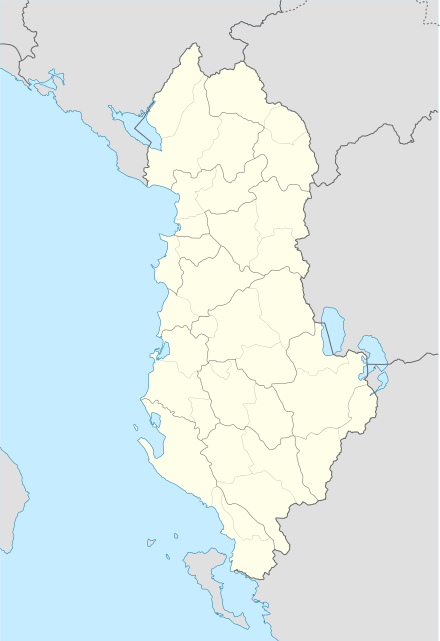Pogon, Albania
Pogon (Greek: Πωγώνι, Pogoni) is a former municipality in the Gjirokastër County, southern Albania. At the 2015 local government reform it became a subdivision of the municipality Dropull.[1] The population at the 2011 census was 432.[2] It consists of seven villages: Poliçan, Skore, Hllomo, Sopik, Mavrojer, Çatistë and Selckë, of which Poliçan is the administrative center.[3] The administrative unit of Pogon is inhabited by ethnic Greeks, except for the village of Selckë.
Pogon | |
|---|---|
 Pogon | |
| Coordinates: 40°8′N 20°21′E | |
| Country | |
| County | Gjirokastër |
| Municipality | Dropull |
| • Municipal unit | 177.6 km2 (68.6 sq mi) |
| Population (2011) | |
| • Municipal unit | 432 |
| • Municipal unit density | 2.4/km2 (6.3/sq mi) |
| Time zone | UTC+1 (CET) |
| • Summer (DST) | UTC+2 (CEST) |
| Vehicle registration | GJ |
Demographics
Greek is spoken in Poliçan, Skore, Hllomo, Sopik, Mavrojer and Çatistë and those villages along with Drimadhes on the Greek side of the border comprise the sub-region of Paleo-Pogoni (Old Pogoni),[4] part of the wider region of Pogoni. Traditionally Greeks of Pogoni in Albania practised endogamy by intermarrying within their group, although occasionally brides from Zagori were taught to speak Greek.[4] Poliçan is the northernmost Greek speaking village in the Pogoni area, as villages north west of Poliçan are Albanian speaking.[5] Selckë, part of a wider region of Lunxhëria, is traditionally inhabited by an Orthodox Albanian population[4] as well as later Aromanian migrants, while the rest of the villages belong to the Greek minority zone.[6]
History
In 15th century Pogon came under Ottoman rule and became part of the Sanjak of Ioannina.[7] It was a nahiya centre as "Pogun" at Pogun kaza (Its centre was Voştina) in Ergiri sanjak of Yanya Vilayet till 1912. As part of Albania, the municipality is part of the recognized Greek Minority Zone.[8]
Historically each village of Pogon has its own variation of traditional costumes and dresses.[4] The area is part of Pogoni, a region that also includes parts of nearby Pogoni on the Greek side of the border.
Culture
The villages of Pogon (except Selckë) are part of the wider Pogoni region, which is divided between Greece (40 villages) and Albania (7 villages).[9][5] Polyphonic singing, although shared among several ethnic groups, tends to be mostly identified with the Pogoni area.[9]
Notable people
- Sophianos (-1711), local Greek-Orthodox bishop and scholar.
- Pandeli Sotiri, Albanian patriot, main contributor to the modern Albanian alphabet
References
- Law nr. 115/2014 Archived 2015-09-24 at the Wayback Machine
- 2011 census results Archived 2016-03-04 at the Wayback Machine
- Greece – Albania Neighbourhood Programme Archived 2012-03-27 at the Wayback Machine
- Hammond, Nicholas Geoffrey Lemprière (1967). Epirus: the Geography, the Ancient Remains, the History and Topography of Epirus and Adjacent Areas. Oxford: Clarendon Press. p. 29. ISBN 9780198142539.CS1 maint: ref=harv (link) "Pogoni, or Paleo-Pogoni as the people call it, consists of seven Greek-speaking villages nearly 3,000 ft. above sea level (Poliçan, Skorë, Hlomo, Sopik, Mavrojer, Çatistë, and the Greek side of the frontier, Drimadhes).... The Pogoniates normally only marry within their own group, but occasionally a bride may be taken from Zagorië and she is taught Greek."; p. 213. "Selck, an Albanian speaking village of some thirty-five houses"
- Hammond 1967, pp. 213 "With a population of 2,500 Poliçan is the largest village in the long-rift within the double range of Nemerçkë. The villages to the north-west are Albanian-speaking, while those to the south speak Greek as their mother tongue. Poliçan therefore regards itself as the most northerly village of the area Pogoni."
- Malo, Foto, Emra vendesh në krahinën e Lunxhërisë (Toponyms in Lunxhëri region) (in Albanian), Tribuna, archived from the original on 2014-04-30, retrieved 2013-08-29
- H. Karpat, Kemal (1985). Ottoman population, 1830-1914: demographic and social characteristics. p. 146. Retrieved 22 September 2011.
- Green, Sarah F. (2005). Notes from the Balkans : locating marginality and ambiguity on the Greek-Albanian border. Princeton, NJ [u.a.]: Princeton Univ. Press. ISBN 978-0-691-12198-7.
- Tziovas, edited by Dimitris (2003). Greece and the Balkans : identities, perceptions and cultural encounters since the Enlightenment. Aldershot, England: Ashgate. p. 196. ISBN 9780754609988.
Although it characterizes many local communities and ethnic groups, such as Vlach and Albanian speakers, it tends to be mostly identified with the Pogoni area, which, ironically enough, is divided between Greece and Albania, seven villages belonging to the latter. Of the rest, about forty villages belong to Greece)
CS1 maint: extra text: authors list (link)
Further reading
- ΖΩΤΟΥ, ΜΕΝΕΛΑΟΥ; ΓΙΑΝΝΑΡΟΥ, ΧΡΙΣΤΟΦΟΡΟΥ. Η ΠΟΛΥΤΣΑΝΗ ΤΗΣ ΒΟΡΕΙΟΥ ΗΠΕΙΡΟΥ. ΕΚΔΟΣΕΙΣ, ΙΩΑΝΝΙΝΑ, 1989. (in Greek)
- Politsanitika Nea Newspaper, Tel. +30 210 5238058 (in Greek)
See also
- Mount Nemërçkë

